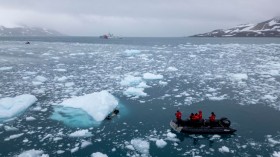As we are now faced with climate change issues, scientists have predicted that animals will seek out more comfortable environs in order to prevent from extinction.
To reveal how persistent environmental changes will affect the animals spatially, a team of scientists from the University of Washington and the Nature Conservancy has developed a new interactive map to show the predicted "migratory paths" of various animal species.
The map reveals that in general, animals will move to places with higher altitudes as areas where they lived for years become drier and hotter.
According to the news release published by the University of Washington, the visualization draws upon flow models from electronic circuit theory, taking inspiration from existing visualizations of wind flow across the U.S.
"This is the best visualization of any of these studies we've done. It's much more compelling than our static maps," said Joshua Lawler, a UW professor in the School of Environmental and Forest Sciences and lead author of the study informing this animated map. "The flow diagram really makes the data much more accessible."
United Press International notes that the mapping began in 2013 when Lawler and his colleague started to identify portions of the earth where the animals would seek refuge. To perfectly demonstrate the flow, they asked Dan Majka with the Conservancy's science team to produce an animated version. Each color on the map represents mammals, birds and amphibians.
For the map, the most obvious movements include North American animals shifting northward along conduits carved out by the Rocky Mountains and the Appalachians while South America's most seen pattern is the westward exodus from the Amazon.
The scientists emphasized that while animal migration has been documented for the past centuries. The forecasted migration will be more troublesome than the previous. Because most places are now highly urbanized, the animals would find it hard to look for special areas.
Check out the map here.
© 2024 NatureWorldNews.com All rights reserved. Do not reproduce without permission.



![Extreme Heat Wave in Africa’s Sahel Region That Killed 100 People Linked to Climate Change [Study]](https://1471793142.rsc.cdn77.org/data/thumbs/full/70226/280/157/50/40/extreme-heat-wave-in-africa-s-sahel-region-that-killed-100-people-linked-to-climate-change-study.jpg)

